Lenovo Legion 5i (17″ Intel, 2021) review – is it really this good?
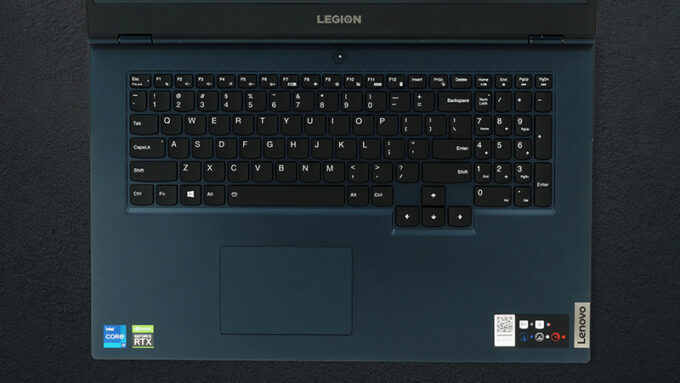 As arguably the most popular notebook on the market, the Legion 5 has shared its fair share of success. However, this year, you get a total of 6 options to choose from – two 15-inch, two 17-inch, and two 16-inch Pro models. Why two each? Well, because AMD is now a true player in the laptop field. However, Lenovo has shown that its love for Intel is still alive, and today we are going to review the Legion 5i (17″ Intel, 2021).
As arguably the most popular notebook on the market, the Legion 5 has shared its fair share of success. However, this year, you get a total of 6 options to choose from – two 15-inch, two 17-inch, and two 16-inch Pro models. Why two each? Well, because AMD is now a true player in the laptop field. However, Lenovo has shown that its love for Intel is still alive, and today we are going to review the Legion 5i (17″ Intel, 2021).
Generally, you will get the tried and tested outfit low-key outfit, but as you can take from the naming – this time, we got the 17-inch model. Quite frankly, it’s definitely not the thinnest and lightest out there, but we expect to see some fierce competition between it, the ASUS ROG Strix G17 G713, and the MSI GP76 Leopard.
So what will the Legion 5i bring to this battle? Of course, you can’t carry a knife to a gunfight, so here we have a Core i7-11800H and RTX 3060 (130W) combo. It also gets a 144Hz 1080p panel, and lo and behold – a MUX switch. Why is it so important? Well, because without it, the integrated graphics card carries the weight of translating the pixels from the dedicated GPU to the display. Instead, the MUX switch allows all of the bandwidth to be accessed, which improves the performance when using the laptop’s own display.
You can check the prices and configurations in our Specs System: https://laptopmedia.com/series/lenovo-legion-5i-17-2021/
Contents
Specs Sheet
- HDD/SSD
- up to 4000GB SSD + up to 1000GB HDD
- M.2 Slot
- 1x 2280 M.2 PCIe 4.0 x4 + 1x 2280 M.2 PCIe 3.0 x4 See photo
- RAM
- up to 64GB
- OS
- Windows 11 Home, Windows 10 Pro, Windows 10 Home, Windows 11 Pro, No OS
- Battery
- 80Wh, 4-cell, 80Wh
- Body material
- Plastic / Polycarbonate
- Dimensions
- 398.6 x 290 x 24.3 ~ 26.2 mm (15.69" x 11.42" x 0.96")
- Weight
- 2.98 kg (6.6 lbs)
- Ports and connectivity
- 1x USB Type-A
- 3.2 Gen 1 (5 Gbps), Sleep and Charge
- 3x USB Type-A
- 3.2 Gen 1 (5 Gbps)
- 1x USB Type-C
- Thunderbolt 4, DisplayPort
- 1x USB Type-C
- Thunderbolt 4, Power Delivery (PD), DisplayPort
- HDMI
- 2.1
- Card reader
- SD
- Ethernet LAN
- 10, 100, 1000 Mbit/s
- Wi-Fi
- 802.11ax
- Bluetooth
- 5.1
- Audio jack
- 3.5mm Combo Jack
- Features
- Fingerprint reader
- Web camera
- HD
- Backlit keyboard
- Microphone
- Dual Array Microphone
- Speakers
- 2x 2W, Nahimic 3D Audio
- Optical drive
- Security Lock slot
All Lenovo Legion 5 / 5i (17″ Intel, 2021) configurations
What’s in the box?
The packaging of this notebook is pretty standard. You get the mandatory paperwork, a 230W charger, and the laptop itself.
Design and construction
Unsurprisingly, the device is entirely made out of plastic. After all, this material is light and cheap, so we can’t argue with Lenovo for their choice. Well, the Legion 5i 17 can’t be described exactly as a thin and light laptop with its near 3kg weight and thickness of 24.3-26.2mm. Nevertheless, it has the signature extended back end, and general design philosophy Lenovo follows for the past few years. And although we observed some flex in the lid and the chassis, we can’t say it’s too much, whatsoever.
The lid here opens with a single hand, but in our opinion, the reason for that can be traced to the rather heavy base. Thankfully, the bezels around the matte display are thin (with the exception of the bottom one). Whereas the top one houses an HD camera with a privacy shutter.
Next, we have the base cover. Due to its huge area, the touchpad seems pretty small. Thankfully, it is equipped with a Mylar cover, which offers a decent gliding experience. Also, we found it pretty accurate.
How about the keyboard? Well, surprisingly, it has shallower key travel than that of its 15-inch sibling. It is pretty comfortable nonetheless, and the huge Arrow keys are a real treat to the users. Our unit has a white backlight, and according to Lenovo, this is the only option available, which is not too bad if you don’t fancy the obnoxious RGB.
Traditionally, the bottom panel is home to the speaker cutouts and a huge ventilation grill. Hot air is exhausted from a total of four vents – two of them are located on the back plus one on each side of the notebook.
Ports
On the left side, there is a Thunderbolt 4 connector and an audio jack. Then, on the right, you get a USB Type-A 3.2 (Gen. 1) port and an SD card reader. Lastly, on the back, there are three USB Type-A 3.2 (Gen. 1) ports, a Thunderbolt 4 connector, a LAN port, an HDMI 2.1 connector, and a power plug. Quite an extensive I/O, which is probably one of the widest on the market.
Disassembly, upgrade options, and maintenance
To take this laptop apart, you need to undo 10 Phillips-head screws. After that, pry the bottom panel with a plastic tool and remove it from the chassis. Keep in mind that you may need to apply more force in the area around the side vents.
Inside, we see a reasonably big 80Wh battery pack. Should you ever need to remove it, you can do so by unscrewing all 6 Phillips-head screws. Don’t forget to unplug the battery connector.
In terms of upgrade options, there are two SODIMM slots for memory expansion hidden beneath a metal shroud. They support a maximum of 64GB in total and work in dual-channel mode. Additionally, you get two M.2 slots, one of which can hold PCIe Gen 4 drives. To access all of the storage ports, you need to remove the metal cooling plates.
Cooling-wise, there are three rather big heat pipes. They are split between the CPU and the GPU and connect to a total of four heat sinks. Moreover, Lenovo has installed two heat spreaders, that manage the temperatures of the VRMs and the graphics memory.
Display quality
Lenovo Legion 5i (17″ Intel, 2021) has a 144Hz Full HD IPS screen, model number Innolux N173HCE-G33 (CMN175C). Its diagonal is 17.3″ (43.94 cm), and the resolution – 1920 х 1080. Additionally, the screen ratio is 16:9, the pixel density – 127 ppi, their pitch – 0.2 x 0.2 mm. The screen can be considered Retina when viewed from at least 69 cm (from this distance, the average human eye can’t see the individual pixels).
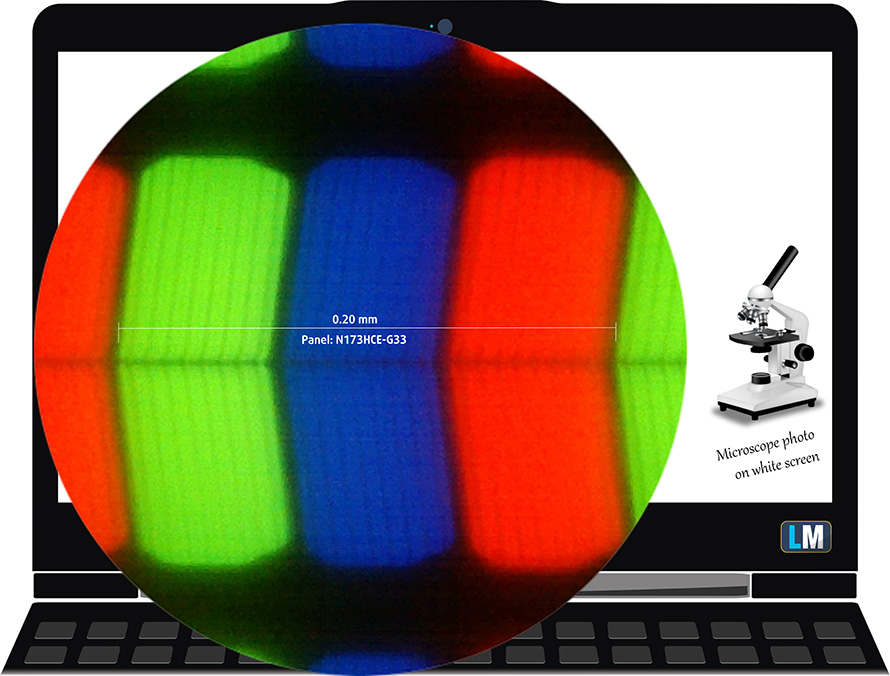
Its viewing angles are comfortable. We have provided images at 45 degrees to evaluate quality.

Also, a video with locked focus and exposure.
The maximum measured brightness is 329 nits (cd/m2) in the middle of the screen and 311 nits (cd/m2) average across the surface with a maximum deviation of 12%. The Correlated Color Temperature on a white screen and at maximum brightness is 6570K (average) – almost matching the 6500K optimum for sRGB.
In the illustration below you can see how the display performs from a uniformity perspective. The illustration below shows how matters are for operational brightness levels (approximately 140 nits) – in this particular case at 81% Brightness (White level = 140 cd/m2, Black level = 0.085 cd/m2).
Values of dE2000 over 4.0 should not occur, and this parameter is one of the first you should check if you intend to use the laptop for color-sensitive work (a maximum tolerance of 2.0 ). The contrast ratio is very good – 1630:1.
To make sure we are on the same page, we would like to give you a little introduction to the sRGB color gamut and the Adobe RGB. To start, there’s the CIE 1976 Uniform Chromaticity Diagram that represents the visible specter of colors by the human eye, giving you a better perception of the color gamut coverage and the color accuracy.
Inside the black triangle, you will see the standard color gamut (sRGB) that is being used by millions of people on HDTV and on the web. As for the Adobe RGB, this is used in professional cameras, monitors, etc for printing. Basically, colors inside the black triangle are used by everyone and this is the essential part of the color quality and color accuracy of a mainstream notebook.
Still, we’ve included other color spaces like the famous DCI-P3 standard used by movie studios, as well as the digital UHD Rec.2020 standard. Rec.2020, however, is still a thing of the future and it’s difficult for today’s displays to cover that well. We’ve also included the so-called Michael Pointer gamut, or Pointer’s gamut, which represents the colors that naturally occur around us every day.
The yellow dotted line shows Lenovo Legion 5i (17″ Intel, 2021)’s color gamut coverage.
Its display covers 95% of the sRGB/ITU-R BT.709 (web/HDTV standard) in CIE1976, which provides a vibrant and punchy image.
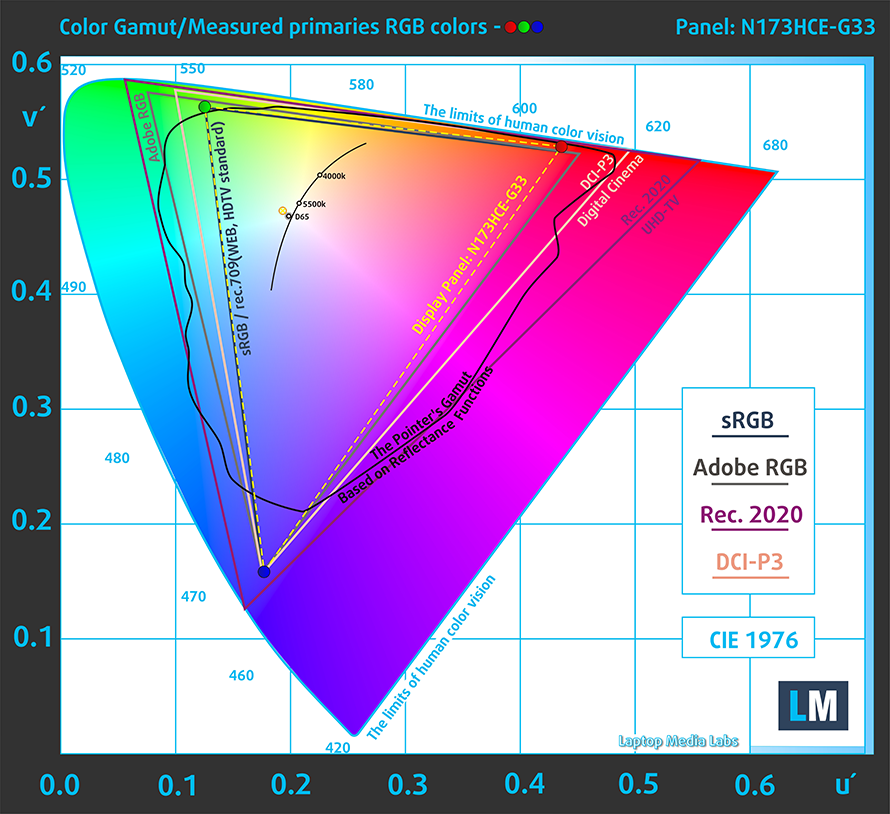
Our “Design and Gaming” profile delivers optimal color temperature (6500K) at 140 cd/m2 luminance and sRGB gamma mode.
We tested the accuracy of the display with 24 commonly used colors like light and dark human skin, blue sky, green grass, orange, etc. You can check out the results at factory condition and also, with the “Design and Gaming” profile.
Below you can compare the scores of Lenovo Legion 5i (17″ Intel, 2021) with the default settings (left), and with the “Gaming and Web design” profile (right).
The next figure shows how well the display is able to reproduce really dark parts of an image, which is essential when watching movies or playing games in low ambient light.
The left side of the image represents the display with stock settings, while the right one is with the “Gaming and Web Design” profile activated. On the horizontal axis, you will find the grayscale, and on the vertical axis – the luminance of the display. On the two graphs below you can easily check for yourself how your display handles the darkest nuances but keep in mind that this also depends on the settings of your current display, the calibration, the viewing angle, and the surrounding light conditions.
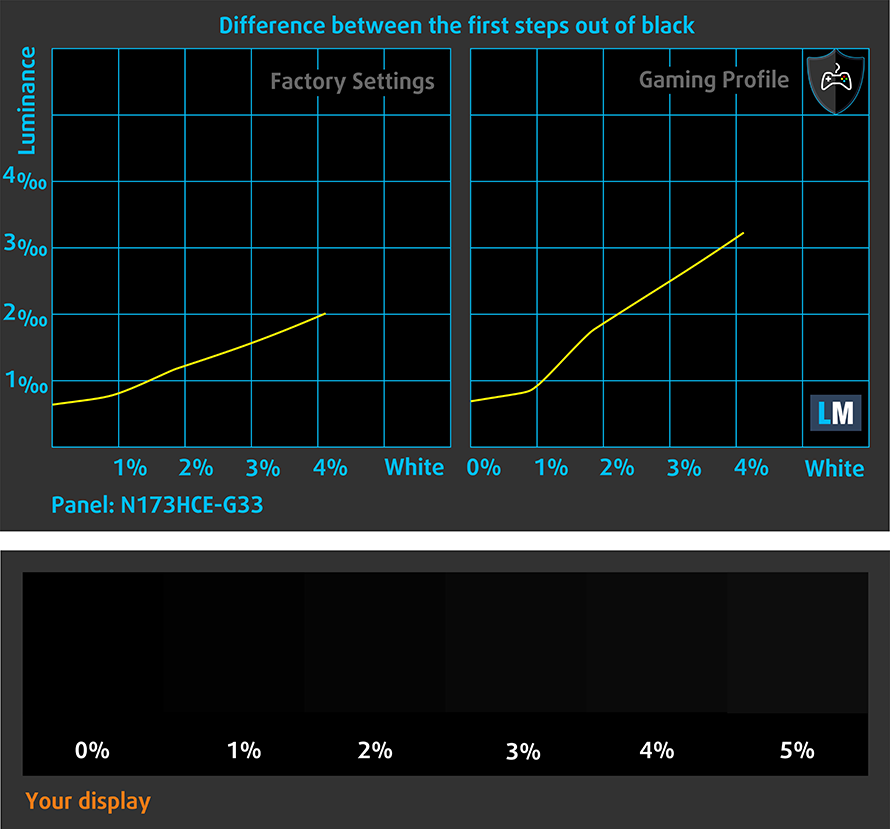
Response time (Gaming capabilities)
We test the reaction time of the pixels with the usual “black-to-white” and “white-to-black” method from 10% to 90% and vice versa.
We recorded Fall Time + Rise Time = 9 ms.
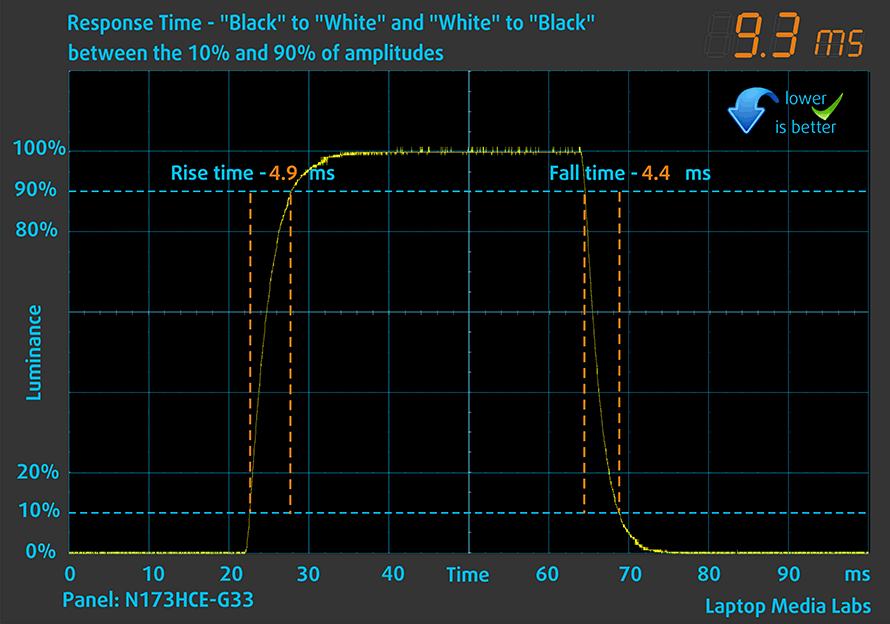
After that, we test the reaction time of the pixels with the usual “Gray-to-Gray” method from 50% White to 80% White and vice versa between 10% and 90% of the amplitude.
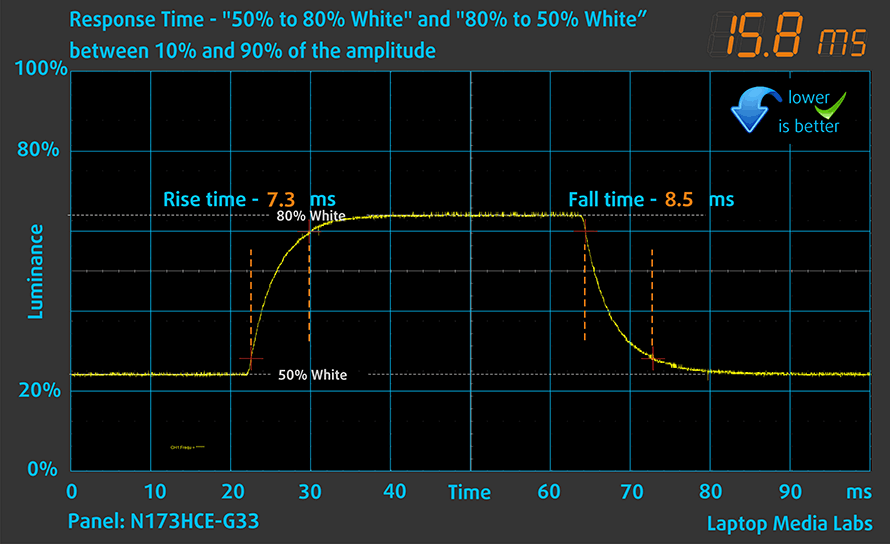
Health impact – PWM / Blue Light
PWM (Screen flickering)
Pulse-width modulation (PWM) is an easy way to control monitor brightness. When you lower the brightness, the light intensity of the backlight is not lowered, but instead turned off and on by the electronics with a frequency indistinguishable to the human eye. In these light impulses, the light/no-light time ratio varies, while brightness remains unchanged, which is harmful to your eyes. You can read more about that in our dedicated article on PWM.
Lenovo Legion 5i (17″ Intel, 2021)’s backlight doesn’t use PWM for brightness adjustment. This makes it comfortable for long periods of use and safe in this aspect.

Blue light emissions
Installing our Health-Guard profile not only eliminates PWM but also reduces the harmful Blue Light emissions while keeping the colors of the screen perceptually accurate. If you’re not familiar with the Blue light, the TL;DR version is – emissions that negatively affect your eyes, skin, and your whole body. You can find more information about that in our dedicated article on Blue Light.
Buy our profiles
Since our profiles are tailored for each individual display model, this article and its respective profile package are meant for Lenovo Legion 5i (17″ Intel, 2021) configurations with 17.3″ Innolux N173HCE-G33 (CMN175C) (FHD, 1920 × 1080) IPS.
*Should you have problems with downloading the purchased file, try using a different browser to open the link you’ll receive via e-mail. If the download target is a .php file instead of an archive, change the file extension to .zip or contact us at [email protected].
Read more about the profiles HERE.
In addition to receiving efficient and health-friendly profiles, by buying LaptopMedia's products you also support the development of our labs, where we test devices in order to produce the most objective reviews possible.

Office Work
Office Work should be used mostly by users who spend most of the time looking at pieces of text, tables or just surfing. This profile aims to deliver better distinctness and clarity by keeping a flat gamma curve (2.20), native color temperature and perceptually accurate colors.

Design and Gaming
This profile is aimed at designers who work with colors professionally, and for games and movies as well. Design and Gaming takes display panels to their limits, making them as accurate as possible in the sRGB IEC61966-2-1 standard for Web and HDTV, at white point D65.

Health-Guard
Health-Guard eliminates the harmful Pulse-Width Modulation (PWM) and reduces the negative Blue Light which affects our eyes and body. Since it’s custom tailored for every panel, it manages to keep the colors perceptually accurate. Health-Guard simulates paper so the pressure on the eyes is greatly reduced.
Get all 3 profiles with 33% discount
Sound
Lenovo Legion 5i (17″ Intel, 2021)’s speakers are decent. There are no deviations across the entire frequency spectrum, but the maximum volume is not very loud.
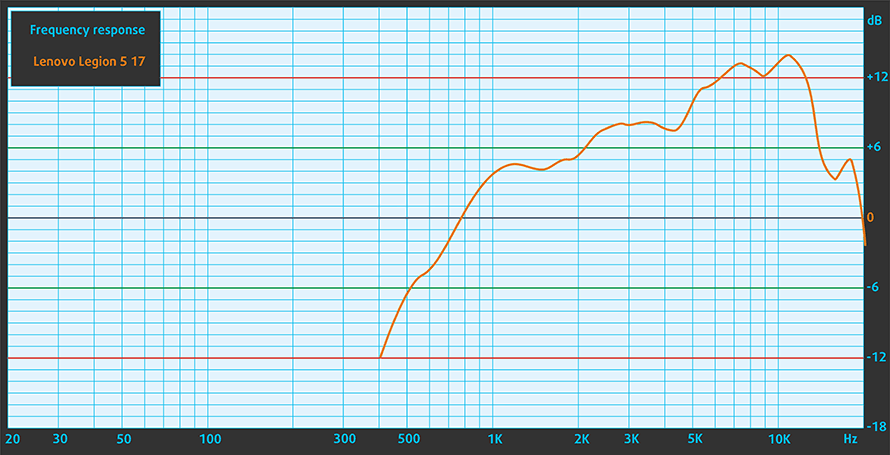
Drivers
All of the drivers and utilities for this notebook can be found here: https://pcsupport.lenovo.com/us/en/products/laptops-and-netbooks/legion-series/legion-5-17ith6h/downloads/driver-list
Battery
Now, we conduct the battery tests with Windows Better performance setting turned on, screen brightness adjusted to 120 nits, and all other programs turned off except for the one we are testing the notebook with. This device’s 80Wh battery lasts for 8 hours and 6 minutes of Web browsing, or 7 hours and 33 minutes of video playback.
In order to simulate real-life conditions, we used our own script for automatic web browsing through over 70 websites.
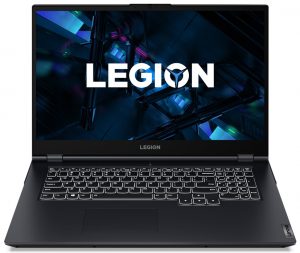

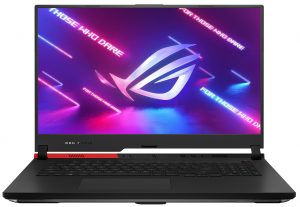
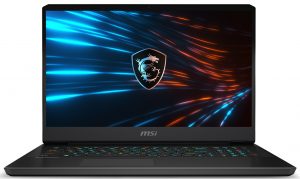
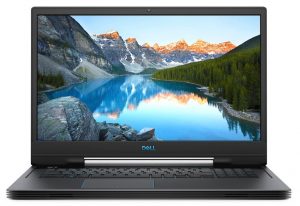
For every test like this, we use the same video in HD.





CPU options
As of the moment of writing this review, this laptop can be purchased with either the Core i5-11400H or the Core i7-11800H.
Results are from the Cinebench 20 CPU test (the higher the score, the better)
Results are from our Photoshop benchmark test (the lower the score, the better)
GPU options
Respectively, the graphics choices go down to the RTX 3050 (95W), RTX 3050 Ti (95W), RTX 3060 (130W), and the RTX 3070 (130W).
Results are from the 3DMark: Time Spy (Graphics) benchmark (higher the score, the better)
Results are from the 3DMark: Fire Strike (Graphics) benchmark (higher the score, the better)
Results are from the 3DMark: Wild Life benchmark (higher the score, the better)
Results are from the Unigine Superposition benchmark (higher the score, the better)
Gaming tests
| Metro Exodus | Full HD, Low (Check settings) | Full HD, High (Check settings) | Full HD, Extreme (Check settings) |
|---|---|---|---|
| Average FPS | 153 fps | 75 fps | 36 fps |
| Borderlands 3 | Full HD, Medium (Check settings) | Full HD, High (Check settings) | Full HD, Badass (Check settings) |
|---|---|---|---|
| Average fps | 125 fps | 95 fps | 76 fps |

| Tom Clancy’s Ghost Recon Wildlands | Full HD, High (Check settings) | Full HD, Very High (Check settings) | Full HD, Ultra (Check settings) |
|---|---|---|---|
| Average | 107 fps | 97 fps | 61 fps |

| Shadow of the Tomb Raider (2018) | Full HD, Medium (Check settings) | Full HD, High (Check settings) | Full HD, Highest (Check settings) |
|---|---|---|---|
| Average | 123 fps | 116 fps | 80 fps |
Temperatures and comfort
Max CPU load
In this test we use 100% on the CPU cores, monitoring their frequencies and chip temperature. The first column shows a computer’s reaction to a short load (2-10 seconds), the second column simulates a serious task (between 15 and 30 seconds), and the third column is a good indicator of how good the laptop is for long loads such as video rendering.
Average core frequency (base frequency + X); CPU temp.
| Intel Core i7-11800H (45W TDP) | 0:02 – 0:10 sec | 0:15 – 0:30 sec | 10:00 – 15:00 min | Max Fans |
|---|---|---|---|---|
| Lenovo Legion 5i (17″ Intel, 2021) | 3.84 GHz (B+67%) @ 96°C @ 113W | 3.69 GHz (B+60%) @ 96°C @ 101W | 3.36 GHz (B+46%) @ 81°C @ 80W | – |
| Dell G15 5511 | 3.67 GHz (B+60%) @ 97°C @ 100W | 3.54 GHz (B+54%) @ 98°C @ 91W | 3.43 GHz (B+49%) @ 93°C @ 79W | – |
| Acer Predator Helios 300 (PH317-55) | 3.67 GHz (B+60%) @ 90°C @ 103W | 3.66 GHz (B+59%) @ 99°C @ 103W | 3.40 GHz (B+48%) @ 99°C @ 84W | – |
| ASUS ROG Zephyrus M16 GU603 | 3.87 GHz (B+68%) @ 95°C @ 106W | 3.90 GHz (B+70%) @ 95°C @ 109W | 3.58 GHz (B+56%) @ 86°C @ 80W | – |
| MSI Creator Z16 (A11Ux) | 3.12 GHz (B+36%) @ 96°C @ 68W | 3.03 GHz (B+32%) @ 95°C @ 62W | 2.76 GHz (B+20%) @ 95°C @ 53W | 2.90 GHz (B+26%) @ 95°C @ 59W |
| MSI GE76 Raider (2021) | 3.22 GHz (B+40%) @ 95°C @ 67W | 3.11 GHz (B+35%) @ 94°C @ 62W | 3.14 GHz (B+37%) @ 94°C @ 61W | 3.26 GHz (B+42%) @ 94°C @ 64W |
| ASUS TUF F15 (FX506, 2021) (Turbo Mode) | 3.98 GHz (B+73%) @ 86°C @ 102W | 3.88 GHz (B+69%) @ 95°C @ 100W | 3.44 GHz (B+50%) @ 87°C @ 77W | – |
| MSI Pulse GL76 | 3.16 GHz (B+37%) @ 95°C @ 65W | 3.00 GHz (B+30%) @ 95°C @ 59W | 2.87 GHz (B+25%) @ 95°C @ 55W | – |
| MSI Pulse GL66 | 2.94 GHz (B+28%) @ 94°C @ 58W | 2.76 GHz (B+20%) @ 94°C @ 52W | 2.77 GHz (B+20%) @ 94°C @ 52W | – |
Here, you can see that the Legion 5i 17″ works pretty well in short loads. However, during long ones, we find that the clock speed is a bit slower than that of the ASUS ROG Zephyrus M16 GU603. On the bright side, the 81°C temperature at the end is pretty respectable.
Real-life gaming
| NVIDIA GeForce RTX 3060 | GPU frequency/ Core temp (after 2 min) | GPU frequency/ Core temp (after 30 min) | GPU frequency/ Core temp (Max Fan) |
|---|---|---|---|
| Lenovo Legion 5i (17″ Intel, 2021) | 1886 MHz @ 75°C @ 127W | 1879 MHz @ 76°C @ 127W | – |
| Dell XPS 17 9710 | 1396 MHz @ 71°C @ 70W | 1403 MHz @ 71°C @ 70W | – |
| Lenovo Legion 7 (16″, 2021) | 1867 MHz @ 70°C @ 126W | 1858 MHz @ 74°C @ 127W | – |
| Lenovo Legion 5 (15″ AMD, 2021) | 1831 MHz @ 75°C @ 129W | 1815 MHz @ 80°C @ 129W | – |
| Lenovo Legion 5 Pro (16″) | 1803 MHz @ 76°C @ 129W | 1787 MHz @ 81°C @ 129W | – |
| MSI GP66 Leopard | 1863 MHz @ 72°C @ 124W | 1852 MHz @ 75°C @ 125W | 1849 MHz @ 69°C @ 127W |
| MSI GP76 Leopard | 1860 MHz @ 71°C @ 129W | 1857 MHz @ 73°C @ 128W | 1869 MHz @ 67°C @ 128W |
On the GPU front, though, we can say that we are perfectly satisfied with the result of this notebook. It’s worth mentioning that Lenovo offers an embedded overclock function in BIOS. It allows you to raise the core clock with 150 MHz, and the memory clock with 300 MHz. In reality, at the second-minute checkpoint, we saw speeds that almost surpass the 2.00 GHz mark (1997 MHz to be precise), while the temperature was 78°C. Unfortunately, it wasn’t stable, and the game crashed at the 15-minute mark, where the clock speed was 1994 MHz at 77°C. We believe that a more modest clock on the core and the memory will work fine, but if you are into undervolting, you can effortlessly reach 2.00 GHz.
Gaming comfort
Expectedly, the laptop was pretty loud when gaming. However, we’ve experienced noisier fans. Also, the temperature on the outside was not too high either.
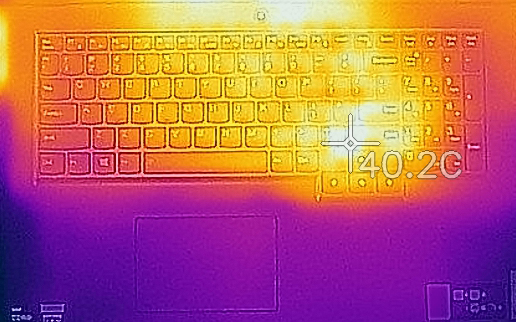
Verdict
 A day of testing the Legion 5i (17″ Intel, 2021) is a day well spent. This laptop is super snappy and has the performance to conquer pretty much every AAA title. In our experience, you don’t even need to use the overclocking function. Firstly, because the 130W RTX 3060 works at quite high clocks at default, and secondly because the laptop (at least our unit) is not able to maintain the max OC available through the BIOS setting.
A day of testing the Legion 5i (17″ Intel, 2021) is a day well spent. This laptop is super snappy and has the performance to conquer pretty much every AAA title. In our experience, you don’t even need to use the overclocking function. Firstly, because the 130W RTX 3060 works at quite high clocks at default, and secondly because the laptop (at least our unit) is not able to maintain the max OC available through the BIOS setting.
Nevertheless, it is one of the best performing Core i7-11800H laptops we’ve tested. That’s great because this CPU is probably the best mobile chip for gaming (and creative work).
Lenovo Legion 5i (17″ Intel, 2021)’s 144Hz IPS panel has a Full HD resolution, comfortable viewing angles, and a very good contrast ratio. In addition, it covers 95% of the sRGB color gamut, and our Gaming and Web design profile helps it reach a standard-matching color accuracy. What is even better for gamers is that the pixel response times are pretty fast, and there is no PWM for brightness adjustment.
In addition to that, you get the standard upgrade options for a gaming notebook – two SODIMM slots for RAM, and two M.2 slots for storage. Thankfully, Lenovo makes full use of the architecture, and you are allowed to fit PCIe Gen 4 drives in one of the slots.
There is another feature of the Tiger Lake CPUs, and it is Thunderbolt 4 support. Does the Legion 5i have it? You bet! There are two of them. Plus, there are four USB Type-A ports, an HDMI 2.1 connector, a LAN port, and an SD card reader. This is hands down the best I/O on a gaming laptop.
And thanks to the MUX switch on this device, you can take advantage of the maximum power of the hardware, while still having the option to get decent battery life. With the setting turned to “hybrid mode”, we got 8 hours of Web browsing, or 7 hours and a half of video playback.
Generally, there is no bad word we can say about the device. Probably it’s petty that the only material used for the body is plastic. And perhaps the speakers are not top of the line but, to be frank, these are sacrifices we are 100% willing to make, especially considering the price tag of the laptop.
You can check the prices and configurations in our Specs System: https://laptopmedia.com/series/lenovo-legion-5i-17-2021/
Pros
- Good keyboard with decent travel and clicky feedback
- High TGP GPUs
- Great upgradeability + PCIe Gen 4 support
- Snappy 144Hz panel with quick response times (Innolux N173HCE-G33)
- 95% sRGB coverage and accurate color representation with our Gaming and Web design profile (Innolux N173HCE-G33)
- Doesn’t get too hot during long gaming sessions
- No PWM (Innolux N173HCE-G33)
- 2x Thunderbolt 4 + SD card reader and the widest I/O out there
- Decent battery life
Cons
- Plastic shell (although with decent quality)
- Not the best speakers
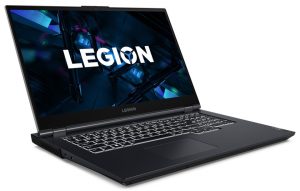
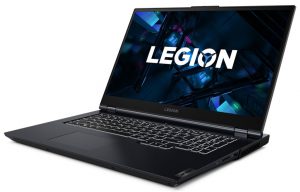
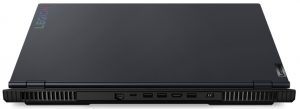
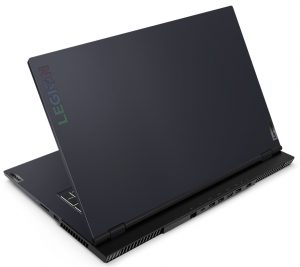
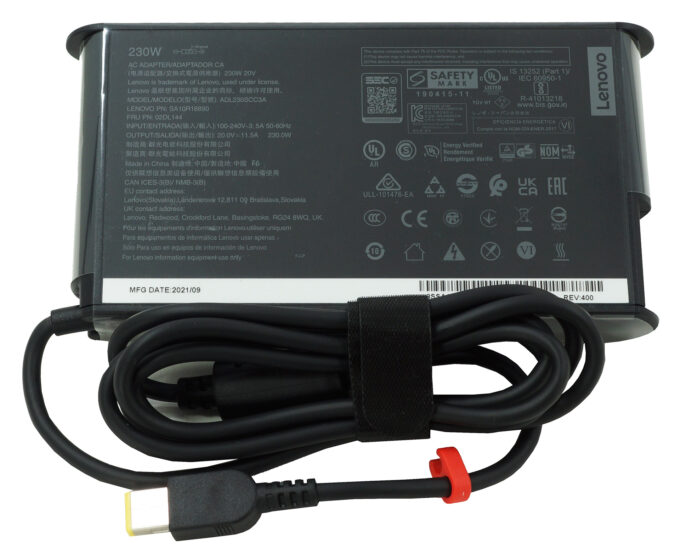
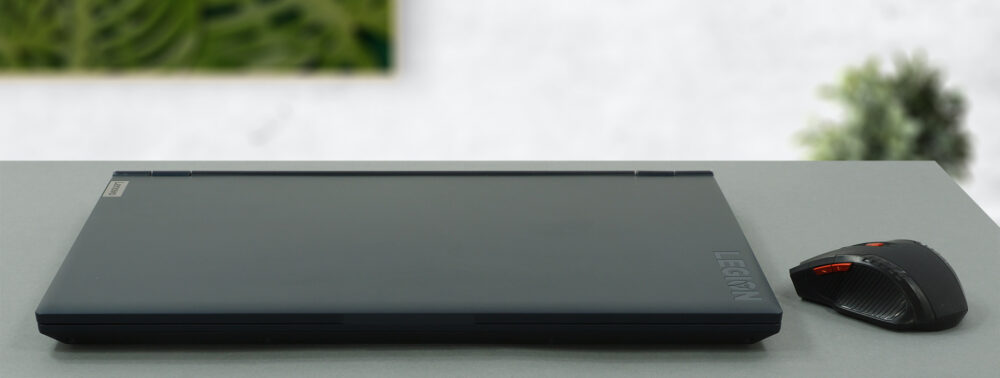

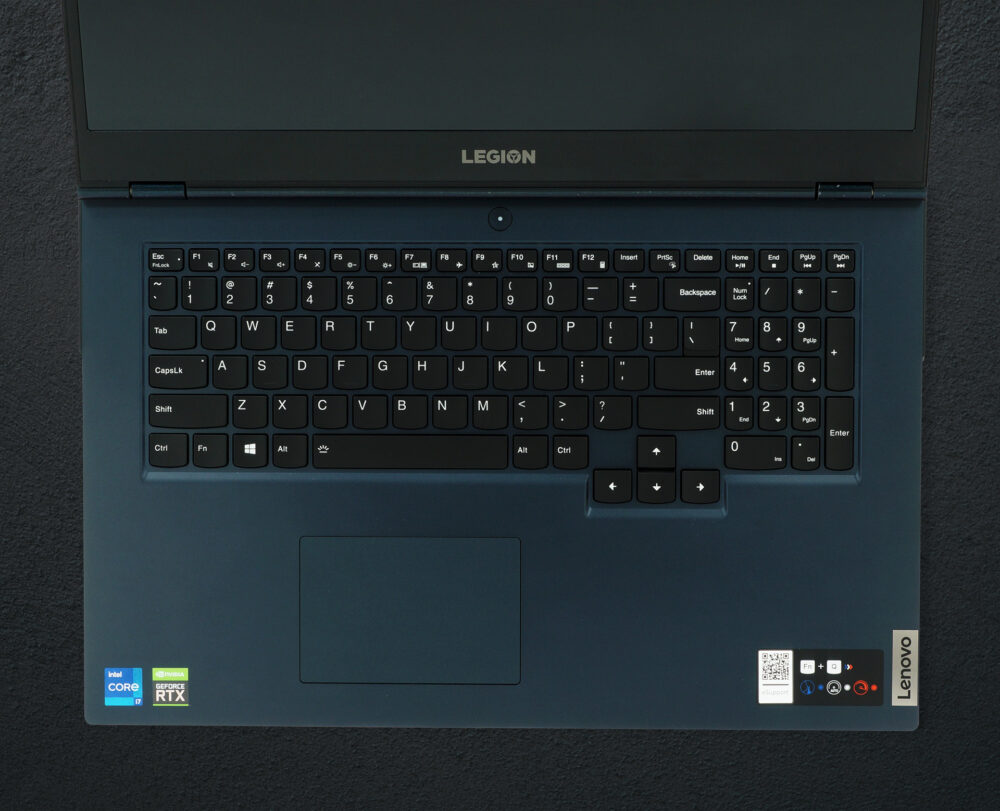

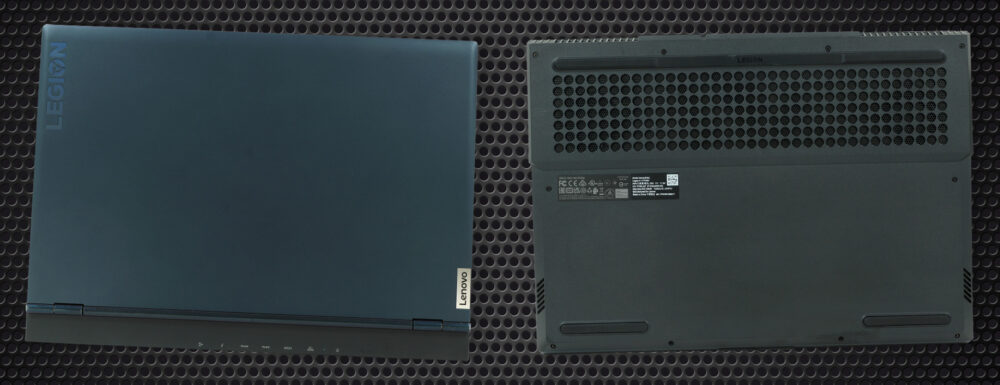




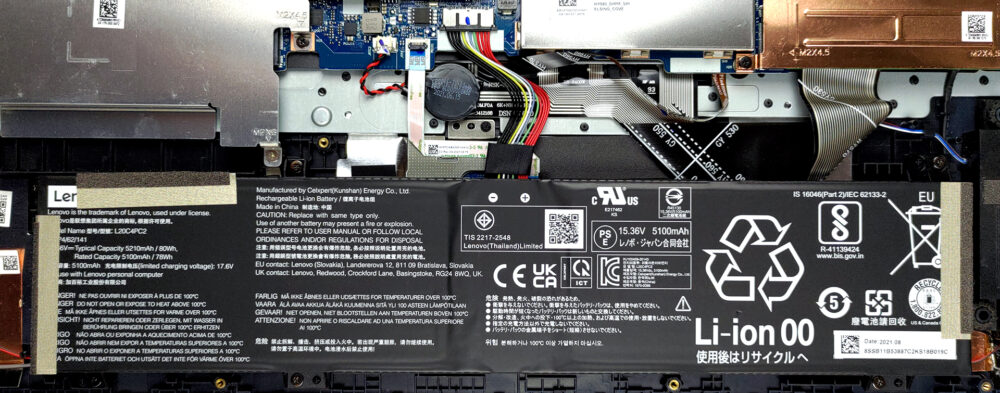
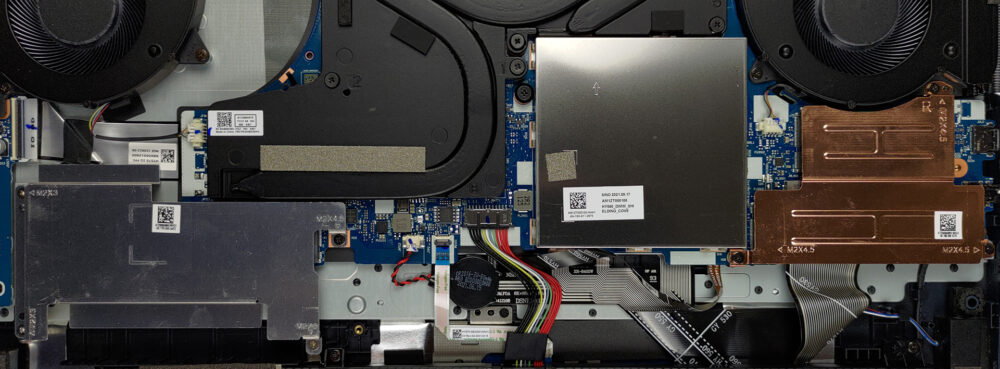
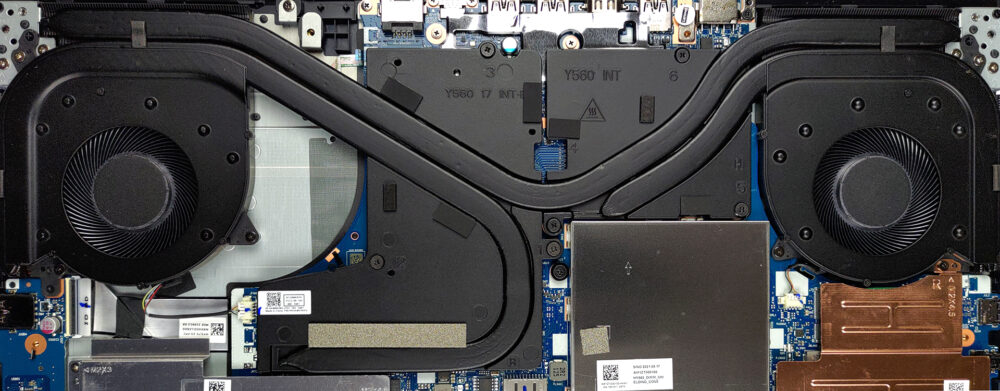
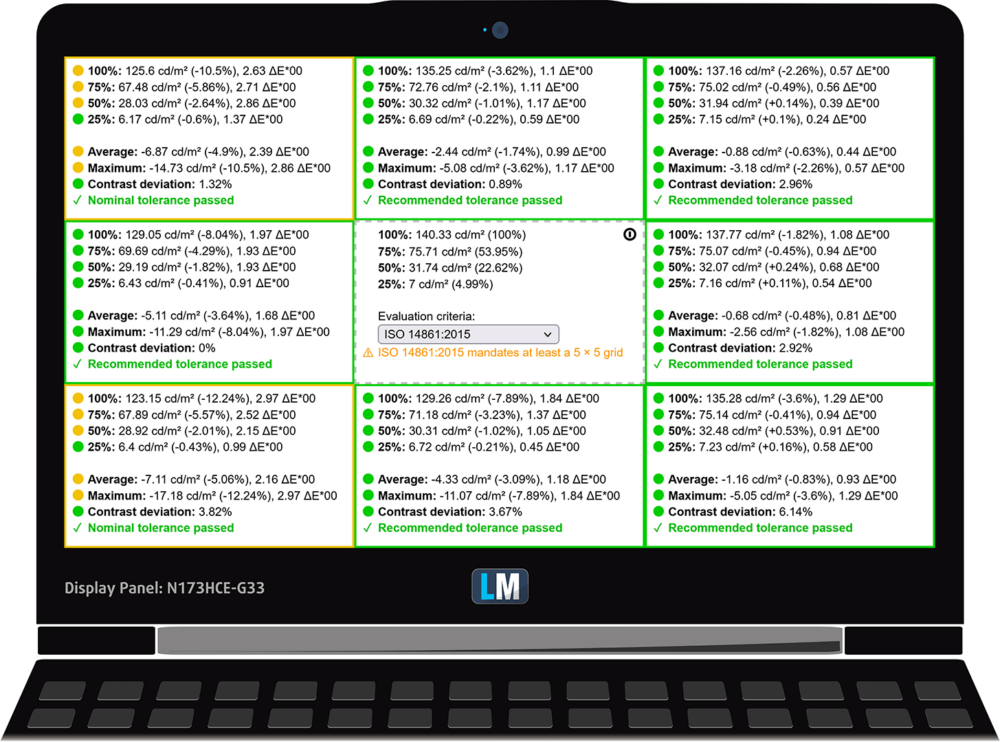



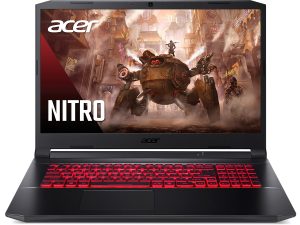
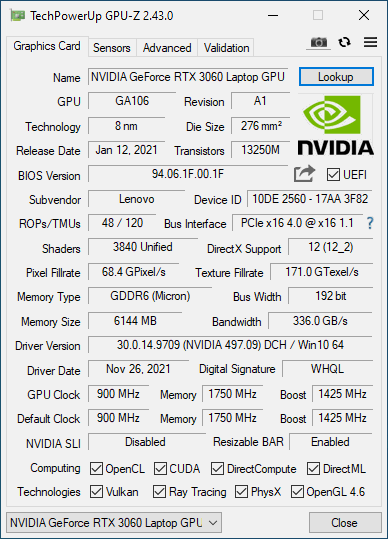










Very good!!!